Where to Go Backcountry Skiing in New England
The latest trend in New England ski resorts is — skipping them altogether? Indeed, it seems like more New Englanders than ever are grabbing their skis and heading to the backcountry.
"It's a perfect storm of things coming together that have raised interest in backcountry skiing this year," said Kurt Niiler, author of "Presidential Skiing: A Guide To Backcountry Skiing In New Hampshire's Presidential Range." Niiler thinks skiers are foregoing chairlifts this season thanks to the availability of backcountry gear, which is lighter and stronger than ever before, as well as the fluid and often frustrating ways the resorts have felt with the Covid-19 pandemic. "With reservation systems at the resorts, and the cost of lift tickets, I can't say I'm surprised that people are re-aligning their priorities."
Ask ten different backcountry skiers how to get involved in the sport and you're likely to get ten different answers, but here's the common denominator of gear you'll need: some "alpine touring bindings" which connect at the toe and allow your ankle to lift up freely; and some "climbing skins," polyester mohair strips which create one-way friction so your ski can move forward without sliding back. Combined, these two things essentially turn your skis into a sort of snow shoe — so your next skiing adventure is limited only by how adventurous of a hike you want to put in.
Of course, backcountry skiing means you're on your own in the wilderness, without the safety net of groomed trails or having a ski patrol in case of emergency. An understanding of outdoor safety skills and how to navigate without the use of a cell phone will prove useful. And while New England isn't necessarily known for its avalanches, they can be common in the backcountry, especially at higher elevations. Wherever you're heading in the Northeast, visit the Mount Washington Avalanche Center website to learn more. If it's your first time out, you might even want to consider hiring a guide for the day.
With all of that being said, if you've built up some courage, gathered the proper gear and are ready to "earn your turns," as the saying goes, here are some of the best places in New England to try your luck with backcountry skiing.
Granite Backcountry Alliance — New Hampshire
This Granite State non-profit cuts and manages a number of gladed ski trails which are perfect for backcountry novices. The trails are clear and easy to navigate, and the GBA's website always lists the best places for pre- and après-ski eats before and after your adventure. GBA founder Tyler Ray suggests first-timers visit the GBA's Crescent Ridge Glade in Randolph, New Hampshire. "Crescent Ridge is a great zone that has incredible views and some really good skiing," said Ray. "It's also home to the Randy Cloud, its own microclimate, and has its own ability to produce significant snowstorms."
RASTA — Vermont
The Green Mountain State is known for its numerous ski resorts, but this organization in the state's central region maintains a number of backcountry zones far from the lift lines. Before planning your visit, spend a little time studying RASTA's interactive online map for a list of local lodging and restaurant partners to really round out your backcountry trip into an
authentic Vermont experience.
Tuckerman Ravine, — New Hampshire
Adrenaline seekers have visited Mount Washington to brave the steeps and chutes of "Tuck's" for over 100 years. While not for newbies (or the faint of heart), New Hampshire's gnarliest alpine ravine still represents a rite of passage for those looking to earn their backcountry stripes. As one of New England's largest swaths of above-treeline terrain, Tuckerman Ravine is notorious for avalanche risk and dangerous weather patterns. Make sure to bring a buddy — and to check the Friends of Tuckerman Ravine website for more information.
Maine Huts & Trails — Maine
These long, gentle, groomed trails in Maine's rugged western region are perhaps more suited to cross-country skis, but they still offer a proper backcountry experience. Inspired by the hut-to-hut skiing culture of the European Alps, this system of trails and huts makes it possible for you to ski all day and then enjoy a hearty lunch and a warm meal at night before skiing on to the next hut the next day. While the huts are currently not open for overnight accommodation due to the Covid-19 pandemic, Maine Huts & Trails is operating its Stratton Brook Hut for daytime use only — offering hot chocolate, lunch and socially-distanced camaraderie.
Mount Watatic — Massachusetts
Located just sixty miles northwest of downtown Boston, this abandoned ski area is a backyard favorite for Bay State skiers. Some of the trails are a bit overgrown, but navigating the trees is part of the fun. Definitely save this one for when you have a bit of backcountry experience under your belt, as it isn't monitored or easily accessed by first responders in case of emergency. But once you're brave enough to give it a go, you'll find this is as good a playground as any in New England for quiet trails, powder stashes, and terrain ranging from steep to gentle.
Source: Read Full Article






